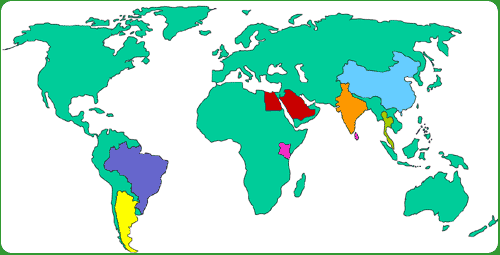| � |
 Scientists
are developing ways to make new genetically modified (GM)
foods that could transform the way we feed ourselves. GM crops
may enable more food to be produced from less land using less
water and fewer chemicals. However, some people question whether
this 'gene revolution' will really reduce hunger in the world.
Others worry that it is being pushed too quickly without enough
consideration of its long-term impact. Scientists
are developing ways to make new genetically modified (GM)
foods that could transform the way we feed ourselves. GM crops
may enable more food to be produced from less land using less
water and fewer chemicals. However, some people question whether
this 'gene revolution' will really reduce hunger in the world.
Others worry that it is being pushed too quickly without enough
consideration of its long-term impact.
From Green to Gene Revolution
In the 1960s, new crops were developed by cross-breeding plants
to create high-yielding varieties, known as the Green Revolution.
Genetic modification goes one stage further. Genes from one
organism are isolated, copied and then inserted into a plant
to give them new characteristics. Scientists argue that unlike
the 'hit and miss' biotechnology of the past, this precise
science means that foods can be developed to suit specific
environments and food needs.
Roll over the icons to find out some of the characteristics
of GM crops that could help the hungry.
A Licence to Farm
Today, much of the research into GM crops is carried out by
biotechnology companies based in the developed world. Once a
new genetic sequence has been identified, these companies can
apply for a 'patent', a kind of licence given to the inventor
to stop rivals making or selling their discovery without his/her
permission. However, some people argue that these companies
have taken genes and local knowledge of plants from elsewhere
and called it their own.
| Most
patents are held by just a handful of transnational
corporations who could make vast profits from these inventions.
But will these new business opportunities over-ride the
need to solve world hunger? |

� Robert Holmgren/Still Pictures |
The benefits for large-scale
farmers in the developing world could be enormous as they invest
in the new technology. But small farmers have traditionally
saved and freely exchanged 70% of their seeds. All this could
change if farmers give up their self-sufficiency and buy into
the gene revolution instead. As well as GM seeds, farmers may
need to buy other inputs such as chemicals to make them grow,
which many can't afford.
Playing with Nature
Small farmers are reluctant to take risks that may damage the
natural environment, the basis of their livelihood. For some,
the risks of releasing GM crops into the natural environment
are difficult to predict and may be irreversible. When GM seeds
mix and breed with their wild relatives, there may be knock-on
effects throughout the ecosystem.
In mixed farming systems, pests and diseases are fought off
by natural predators, but this natural antidote is under threat.
Today, only 20 crop varieties produce 90% of our food, and the
gene revolution could reduce biodiversity (the variety of organisms)
even further. In addition, pest-resistant GM crops may encourage
the emergence of 'super-pests'.

� Simon Scoones/Worldaware. |
Permanent
damage to the natural environment may jeopardise the livelihoods
of small farmers who depend on it for their survival,
like this rice farmer in Cambodia. |
But GM techniques could
help small farmers in marginal lands such as areas prone to
drought or steep hillsides. Also, GM farming may prove more
environmentally friendly as they require less pesticides and
fertilisers and the higher productivity of GM crop fields
may save forests and other natural habitats that would otherwise
be turned into more farmland.
Health Risks?
Critics also express concern over the possible risks to human
health. Some studies of GM foods suggest that if someone with
an allergy eats food that has been spliced with a gene from
shellfish or a peanut, they may experience an allergic reaction.
But supporters of GM technology claim that all this talk of
'Frankenstein foods' is science fiction rather than fact.
GM varieties are among the most tested foodstuffs and there
is no proof that these dangers will occur.

Reactions to the
Gene Revolution
Click on the highlighted sections of the map to find out how
people in different countries in the developing world have
reacted to the Gene Revolution:

Over 3,000 GM foodstuffs
are currently being tested. Whether most GM crops remain in
laboratories and greenhouses or transform the way we produce
food remains an open question, but it will certainly be a
long time before we know the answer.
|
� |





